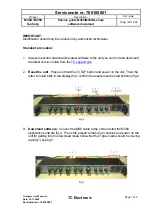
105BCommunication processor
12.3 Point-to-Point (PtP) communication
S7-1200 Programmable controller
532
System Manual, 11/2011, A5E02486680-05
12.3.1
Point-to-Point instructions
12.3.1.1
Common parameters for Point-to-Point instructions
Table 12- 3 Common input parameters for the PTP instructions
Parameter
Description
REQ
Many of the PtP instructions use the REQ input to initiate the operation on a low to high
transition. The REQ input must be high (TRUE) for one execution of an instruction, but the REQ
input can remain TRUE for as long as desired. The instruction does not initiate another operation
until it has been called with the REQ input FALSE so that the instruction can reset the history
state of the REQ input. This is required so that the instruction can detect the low to high transition
to initiate the next operation.
When you place a PtP instruction in your program, STEP 7 prompts you to identify the instance
DB. Use a unique DB for each PtP instruction call. This ensures that each instruction properly
handles inputs such as REQ.
PORT
A port address is assigned during communication device configuration. After configuration, a
default port symbolic name can be selected from the parameter assistant drop-list. The assigned
CM or CB port value is the device configuration property "hardware identifier". The port symbolic
name is assigned in the "Constants" tab of the PLC tag table.
Bit time resolution
Several parameters are specified in a number of bit times at the configured baud rate. Specifying
the parameter in bit times allows the parameter to be independent of baud rate. All parameters
that are in units of bit times can be specified to a maximum number of 65535. However, the
maximum amount of time that a CM or CB can measure is eight seconds.
The DONE, NDR, ERROR, and STATUS output parameters of the PtP instructions provide
execution completion status for the PtP operations.
Table 12- 4 DONE, NDR, ERROR, and STATUS output parameters
Parameter
Data type
Default
Description
DONE
Bool
FALSE
Set TRUE for one execution to indicate that the last request
completed without errors; otherwise, FALSE.
NDR
Bool
FALSE
Set TRUE for one execution to indicate that the requested action
has completed without error and that the new data has been
received; otherwise, FALSE.
ERROR
Bool
FALSE
Set TRUE for one execution to indicate that the last request
completed with errors, with the applicable error code in STATUS;
otherwise, FALSE.
STATUS
Word
0
Result status:
If the DONE or NDR bit is set, then STATUS is set to 0 or to an
informational code.
If the ERROR bit is set, then STATUS is set to an error code.
If none of the above bits are set, then the instruction returns
status results that describe the current state of the function.
STATUS retains its value for the duration of the execution of the
function.
















































